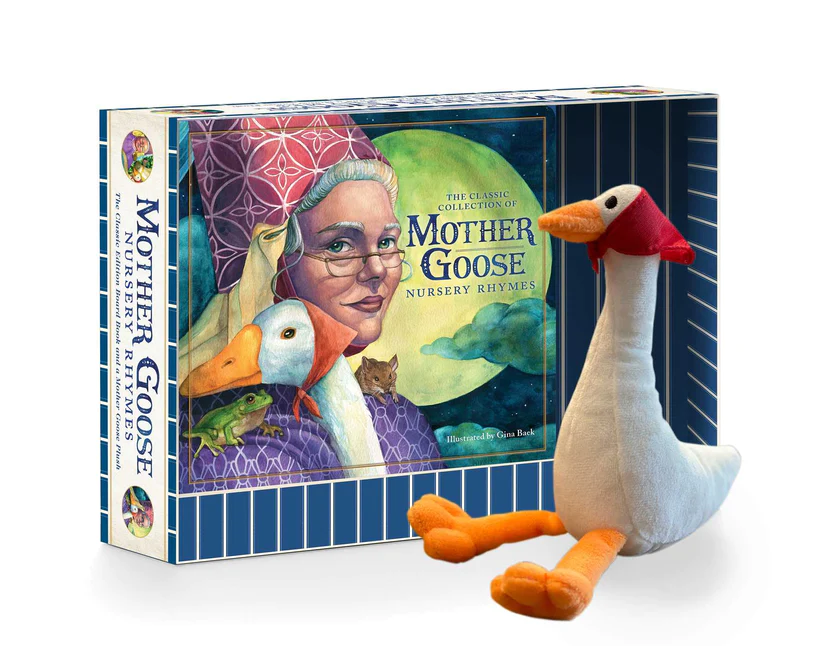A collection of nursery rhymes and stories, many dating back to the fifteenth century or earlier. They are usually grouped around a rural woman archetype or an anthropomorphized gosling character.
INTRODUCTION
“Mother Goose” is a general category of nursery rhymes and stories, usually aimed at toddlers or younger readers. The rhymes have a similar form, sound, and purpose. However, they are a diverse group of lyrical tales with very little in common. The stories we consider canonical Mother Goose Rhymes are an amalgamation of contradictory folk tales and poems. They also differ dramatically in age and content. The rhymes, often introduced to young children as their introduction to literature and language, help them learn how to express their thoughts coherently. Nursery Rhymes have a long history of being nonsensical. However, many come from themes such as political intrigue, old gossip, folklore, or religious allegories. Many nursery rhymes, despite their intended audience, contain disturbing images. Examples include “Little Dicky Dilver,” “Humpty Dumpty,” and “Rock-a-Bye Baby,” which shows a baby falling from a branch. Betty Carter notes that Mother Goose rhymes were originally aural mnemonics, chronicling adult interactions and incidents. As a result of their narrative, they provide a glimpse into the social history of the 16th, 17th, and 18th centuries.
Despite their differences, rhymes for nursery are usually similar in content and format. Nursery rhymes are generally written in poetry with repetitive phrases and imagery. The length of nursery rhymes is generally limited to a few dozen words. They are suited to song and verse, so many have been put to music. This has led to some of the most well-known childhood lullabies. Most are from Europe, with some of the most famous being English-born. However, others can be traced back to American writers. The American writer Sarah Hale wrote “Mary Had a Little Lamb,” which is based on a true story about a student of Sarah’s who tried to bring a lamb alive to school. Hale published this poem in 1830, and it quickly became a Mother Goose rhyme.
The symbol Mother Goose was created in Europe, but her association with sonnets and poetry is primarily American. The first recorded use of “Mother Goose” in English was in 1729 when Charles Perrault translated Contes De Ma Mere l’Oye and Mother Goose Tales. These stories were originally published in French 1695. Around 1780, the famous children’s writer John Newbery published his collection of nursery songs titled Mother Goose’s Melody or, Sonnets for Cradle. The origin of the name “Mother Goose” is unknown, but there are several possible theories. Two of the most robust approaches revolve around a pair of French queens called Bertha. First, the theory claims Bertha derived from the 8th-century Queen Bertha Pepin. She was the mother to Charlemagne. She may have been nicknamed “Queen Goosefoot” due to her deformed foot. Second, the name is attributed to Queen Bertha of the 11th century, the wife of Robert II. It was said that she gave birth to a “goose-headed child” due to the inbreeding among the royal family. Both women were told to be generous with children, which may have helped cement their legacy through stories related to them. Another popular theory involves Queen Sheba and a woman from Boston’s colonial era named Elizabeth Goose, or, more commonly, “Vergoose,” “Vertigoose,” a grandmotherly lady who shared stories of her youth with several local children. Visitors to Boston often visit the presumed grave of this American mother goose at the Granary Burying Ground. However, given the period she lived and the name “Mother Goose,” she cannot have originated.
Perrault was a pioneer in the genre of fairy tales and nursery rhymes. The exact origin is not known, but his contributions were revolutionary. Histoires ou Contes du time passé, avec des Moralitez (1697), a collection of adaptations of myths and folklore, was written in courtesan style, which was popular during that era. The book consisted of eight fairy stories, some of which remain popular today. “La Belle au bois sommeil (The Sleeping Beauty in the Wood), “Le Petit Chaperon Rouge (Little Red Riding Hood), “Barbe Bleue” (Bluebeard), “Le Chat Botte” (The Master Cat, or Puss in Boots), “Les Fees” (The Fairies), “Cendrillon” (Cinderella, or The Little Glass Slipper), Perrault’s stories, including those from Contes De Ma Mere L’Oye and this book, continue to appear in Mother Goose collections. However, they are generally called fairy tales instead of nursery rhymes. Newbery’s Mother Goose Melody was the book that changed the focus of Mother Goose from fairy tales to the short verses and poems familiar to readers today.
Mother Goose rhymes have a diverse background, spanning various times and artistic intentions. Unexpectedly, many of the Mother Goose rhymes were inspired by political and social issues. Mother Goose rhymes mocked political figures such as Mary, Queen of Scots Henry VII HTML The verses “Mary Mary, Quite Contrary” and “Little Miss Muffet” may refer to the reign. One of the most detailed of these political metaphors, “Sing a Song of Sixpence,” is thought to be referring to Henry VIII. Sister Mary Joan Patricia suggests that the story behind the rhyme is about Henry’s “confiscation” of rich abbey land and his divorce with HTML. She views the poem as a criticism of Henry’s poor Kingship. A verse like “Sing A Song Of Sixpence/A Pocket Full of The difficulty of confirming the true intentions of the rhyme’s anonymous and forgotten authors makes it difficult to identify the hidden meaning of such story poems. There are many theories. Even determining their basic origins is difficult, as many of them are adaptations or folk tales that have been repeated over and over again. In the case of Mother Hubbard, the poem’s current form is credited to Sarah Catherine Martin’s Old Mother Hubbard.’
There are thousands of nursery rhymes, and hundreds more have been lost over time. This unfortunate list includes all the original printings for Newbery’s Victorian sentimentalism, which was a stronghold of all things childlike at the time, produced a plethora of nursery rhymes, many with James Orchard Halliwell published The nursery rhymes of England, collected primarily from oral tradition in 1842. This desire to account for the diverse membership of Mother Goose’s canon took on a more scholarly bent in the last century. In particular, two collections that have taken a comprehensive and thoroughly researched approach to establishing a canonical list of all Mother Goose rhymes were praised. These two complete reference books for nursery rhymes are still authoritative today, despite their 50-year-old publication dates. Each year, dozens of Mother Goose collections appear. They often take a different approach to the classic material. Eve Merriam’s Inner City Mother Goose, published in 1969, is among the most innovative editions. It modernizes Merriam-inspired, more recent Mother Goose books to create “twisted nursery rhymes,” which subvert traditional rhymes through satirical and ironic reimagine


